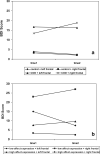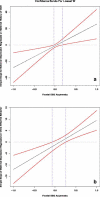Children's affect expression and frontal EEG asymmetry: transactional associations with mothers' depressive symptoms
- PMID: 17851752
- PMCID: PMC3010863
- DOI: 10.1007/s10802-007-9171-y
Children's affect expression and frontal EEG asymmetry: transactional associations with mothers' depressive symptoms
Abstract
Although parents and children are thought to influence one another's affect and behavior, few studies have examined the direction of effects from children to parents, particularly with respect to parental psychopathology. We tested the hypothesis that children's affective characteristics are associated with the course of mothers' depressive symptoms. Children's affect expression was observed during a series of mother-child interaction tasks, and children's resting frontal electroencephalogram (EEG) asymmetry was assessed in a psychophysiology laboratory. Mothers' depressive symptoms were assessed at two time points, approximately one year apart, at the mother-child interaction visits. Depressive symptoms increased over time for mothers with a history of childhood-onset depression whose children exhibited right frontal EEG asymmetry. Depressive symptoms were associated with high child negative affect at both time points for mothers whose children exhibited right frontal EEG asymmetry. Cross-lagged models with a subset of participants provided some evidence of both parent-to-child and child-to-parent directions of effects. Findings suggest that akin to other interpersonal stressors, children's affective characteristics may contribute to maternal depressive symptoms.
Figures



References
-
- Allen NB, Badcock PBT. The social risk hypothesis of depressed mood: Evolutionary, psychosocial, and neurobiological perspectives. Psychological Bulletin. 2003;129(6):1–28. - PubMed
-
- American Psychiatric Association . Diagnostic and statistical manual of mental disorders (dsm–iii) (3rd ed.) American Psychiatric Association; Washington, DC: 1980.
-
- American Psychiatric Association . Diagnostic and statistical manual for mental disorders (dsm–iii–r) (3rd Revised ed.) American Psychiatric Association; Washington, DC: 1987.
-
- American Psychiatric Association . Diagnostic and statistical manual for mental disorders (DSM-IV) (4th ed.) American Psychiatric Association; Washington, DC: 1994.
-
- Bauer DJ, Curran PJ. Probing interaction sin fixed and multilevel regression: Inferential and graphical techniques. Multivariate Behavior Research. 2005;40(3):373–400. - PubMed
Publication types
MeSH terms
Grants and funding
LinkOut - more resources
Full Text Sources

